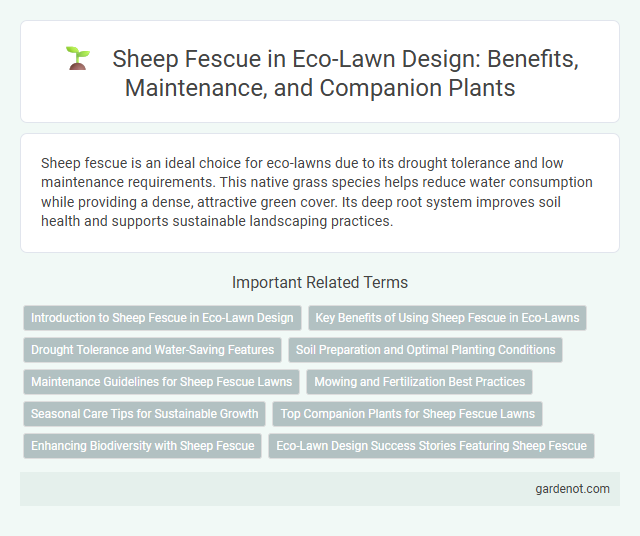Sheep fescue is an ideal choice for eco-lawns due to its drought tolerance and low maintenance requirements. This native grass species helps reduce water consumption while providing a dense, attractive green cover. Its deep root system improves soil health and supports sustainable landscaping practices.
Introduction to Sheep Fescue in Eco-Lawn Design
Sheep fescue (Festuca ovina) is a low-maintenance, drought-tolerant grass species ideal for eco-lawn design, promoting biodiversity and reducing water consumption. Its fine-textured, dense growth habit creates a resilient turf that thrives in poor soils, minimizing the need for fertilizers and pesticides. Incorporating sheep fescue into eco-lawns enhances soil health and supports sustainable landscaping practices.
Key Benefits of Using Sheep Fescue in Eco-Lawns
Sheep fescue is highly drought-tolerant and requires minimal irrigation, making it ideal for eco-lawns aiming to conserve water. Its dense, fine-textured blades provide excellent erosion control and enhance soil health by promoting microbial activity. This grass species thrives in poor soils with low fertility, reducing the need for chemical fertilizers and supporting sustainable lawn maintenance.
Drought Tolerance and Water-Saving Features
Sheep fescue (Festuca ovina) is highly valued for its exceptional drought tolerance, thriving in low-moisture environments with minimal irrigation. Its deep root system efficiently absorbs water, making it an ideal choice for eco-lawn installations focused on water conservation. This grass species significantly reduces the need for supplemental watering, promoting sustainable landscaping and lowering overall water usage.
Soil Preparation and Optimal Planting Conditions
Sheep fescue thrives in well-drained, sandy to loamy soils with a neutral to slightly acidic pH range of 5.5 to 7.0, requiring thorough soil preparation including aeration and removal of debris to enhance root establishment. Optimal planting conditions involve sowing seeds during early spring or early fall when soil temperatures range between 50degF and 65degF, ensuring consistent moisture for germination. Proper soil fertility with balanced nitrogen levels supports dense growth and improves drought tolerance, making Sheep fescue ideal for eco-lawn installations.
Maintenance Guidelines for Sheep Fescue Lawns
Sheep fescue (Festuca ovina) requires low-maintenance care, thriving with minimal watering and infrequent mowing at a height of 2 to 3 inches to maintain its dense, tufted appearance. Fertilize annually with a balanced, slow-release fertilizer in early spring to support steady growth while avoiding excessive nitrogen that can reduce drought tolerance. Regular dethatching in early spring helps prevent thatch buildup and promotes healthy air and water penetration in eco-lawns dominated by sheep fescue.
Mowing and Fertilization Best Practices
Sheep fescue thrives with minimal mowing, ideally kept at a height of 2 to 3 inches to promote healthy growth and prevent stress. Fertilization should be light and infrequent, using low-nitrogen formulas to maintain vibrant green foliage without encouraging excessive growth. Applying organic compost during early spring enhances soil fertility while supporting sustainable eco-lawn practices.
Seasonal Care Tips for Sustainable Growth
Sheep fescue thrives with minimal watering, making it ideal for eco-lawns seeking sustainable growth through water conservation. Mowing should be kept at a height of 2 to 3 inches during the growing season to encourage dense, healthy turf and reduce weed invasion. Applying a slow-release, organic fertilizer in early spring supports nutrient uptake and maintains resilience in drought-prone conditions.
Top Companion Plants for Sheep Fescue Lawns
Sheep fescue thrives alongside other drought-tolerant and low-maintenance plants, making fine fescue, blue grama, and buffalo grass top companion choices for eco-lawns. These species support soil health, promote biodiversity, and enhance resilience against pests and diseases. Integrating these companion plants with sheep fescue creates a sustainable, water-efficient lawn ideal for eco-friendly landscapes.
Enhancing Biodiversity with Sheep Fescue
Sheep fescue (Festuca ovina) supports biodiversity by providing a native, drought-tolerant ground cover that attracts pollinators and beneficial insects. Its fine-textured foliage creates a varied microhabitat, promoting soil health and supporting a diverse range of microorganisms and invertebrates. Integrating sheep fescue into eco-lawns encourages resilient ecosystems and enhances the overall ecological value of green spaces.
Eco-Lawn Design Success Stories Featuring Sheep Fescue
Sheep fescue, a drought-tolerant and low-maintenance grass species, plays a pivotal role in successful Eco-Lawn designs by enhancing soil health and reducing water consumption. Its fine texture and deep root system improve soil structure while providing year-round greenery in sustainable landscapes. Eco-lawn projects featuring sheep fescue demonstrate significant reductions in irrigation needs and chemical inputs, making it an environmentally responsible choice for residential and commercial turf alternatives.
Sheep fescue Infographic

 gardenot.com
gardenot.com